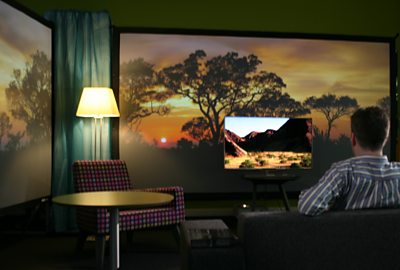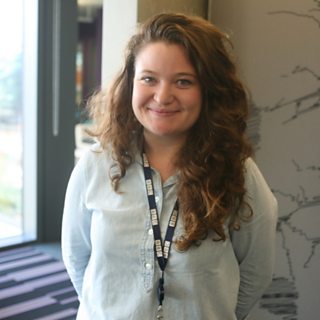We are anticipating the kinds of user experiences that future displays could provide for ΒιΆΉΤΌΕΔ viewers.
Project from 2013 - 2014

What we are doing
Imagine if you could decorate the walls of your home with electronic wallpaper and personalise it at will. What sort of space would you create?
This is just one example of the way our concept of 'screens' is evolving. Other unconventional screens could include smart watches, LED carpets and hand-held pico projectors. As part of our investigation into these unconventional screens, we are currently focusing on the trend towards larger, cheaper, low-power, flexible displays, which we envisage will result in a future where our walls can be covered with electronic 'Smart Wallpaper'.
In our Smart Wallpaper project, our concept of this technology has more in common with e-readers than it does with television displays. Smart Wallpaper will not be backlit but will rely on reflected light for visibility; it will not necessarily be capable of displaying video but will suit βslowerβ content such as graphics and text.
We are not attempting to build the physical technology, instead we are anticipating its emergence and designing potential user experiences. To do this, we have developed a prototype to test out our ideas. As we do not know the exact properties of Smart Wallpaper we have designed our system to be as agnostic as possible to the particular implementation, focusing instead on ubiquitous, standard web technologies. We are confident that any lessons learnt will also be applicable to smaller connected displays that we see being present in homes in the next few years.
Why it matters
Increasingly, people are exploring how experiences can spill beyond the boundaries of their television. In the digital age, we are consuming more and more content: access to Video-on-Demand and online storyline info has allowed dramas to become complex, sports broadcasts are often accompanied by multiple streams of stats, and live commentary on social networks is becoming an essential extra. In response to this, users have started to augment how they experience television with
In parallel, researchers are starting to explore how television can literally spill beyond the rectangular bounds of television onto surrounding walls. Notable such projects include those creating more immersive experiences (, , ), those using the wall as a natural space to place extra media screens and widgets (, ), and those exploring wall space as a forefront content delivery system ().
We think that it is interesting and important to look at these two things at the same time, bearing in mind that large-scale screens have been , and also that content spilling onto the walls surrounding a television has been shown to increase a feeling of immersion ().
Of course, papering the walls of your house with displays could lead to many exciting possibilities, not just those mentioned here. We're interested in building on work that examines how large scale displays can be meaningful play spaces (), and also work that shows large collaborative surfaces can foster a sense of community in shared spaces (). These are both things that we think are interesting when seen in the context of the home.
Our Goals
As part of ΒιΆΉΤΌΕΔ R&D's User Experience Research Partnership (UXRP) we are working with from the University of Bath to investigate three main research areas:
- The types of content that could be suitable for Smart Wallpaper.
We generally consider content on the wall to be either βAmbientβ or βActiveβ. Ambient content is either aesthetic (such as a wallpaper pattern) or something youβre likely to glance at (such as a weather forecast). Active content makes up part of an experience engaging the user, either through increased immersion or by requiring direct attention. An example of immersion could be displaying a panorama of the Serengeti Plains setting the scene for a documentary. An example that requires direct attention is displaying recipe instructions in the kitchen while the user is cooking.
The ΒιΆΉΤΌΕΔ is in a position to provide both active and ambient wallpaper content. We aim to prototype a number of experiences to demonstrate the opportunities available.
- How content could be arranged on the walls.
When we create television programmes we can be reasonably confident that the viewer will be consuming the content on a 16x9 rectangular display. With Smart Wallpaper, everyoneβs rooms are different so we need to develop a system that can automatically layout content to suit the resources available.
This is the evolution of responsive design, where we must account not only for varying dimensions but also for displays of differing shape with some parts occluded. We are investigating force-based layout algorithms as well as different packing algorithms. The optimal solution may be a mix of algorithm and handcrafting.
- How the user could interact with the wallpaper content.
We do not envisage Smart Wallpaper technology being a large touch-screen interface. It is therefore important that the wallpaper requires the minimum of configuration (particularly in ambient mode) and that any interaction is as intuitive as possible. We are considering gesture based interfaces and integration with smart home systems as well as exploiting the suite of interaction technologies provided within smart phones and tablets.
Outcomes
We want to create a tool that will allow quick and easy prototyping of new kinds of user experiences. We can then use this to test which experiences work well and why.
We are undertaking user research to explore the effect displays like Smart Wallpaper can have on feelings of immersion in content when used in companion to television.
There are many more interesting research questions that spring to mind, such as what kind of layout systems would be optimal and how might the user interact with Smart Wallpaper.
We will publish any findings that arise from our research and user studies.
How it works
Our prototype is based on standard web technologies, primarily HTML5 Canvas and JavaScript. It uses a central server that stores state information for all the walls in the home. Any web browser can establish itself as a βwallβ by registering with the server. The server hosts a RESTful API that enables interaction with the wall states and control of the content displayed.
In the absence of real Smart Wallpaper we are using large rear-projection screens for the walls. By placing a television and real furniture in front of the screens we get as close as possible to our vision.
Project Team
Project Partners
-
Part of the University of Bath's Psychology Department


